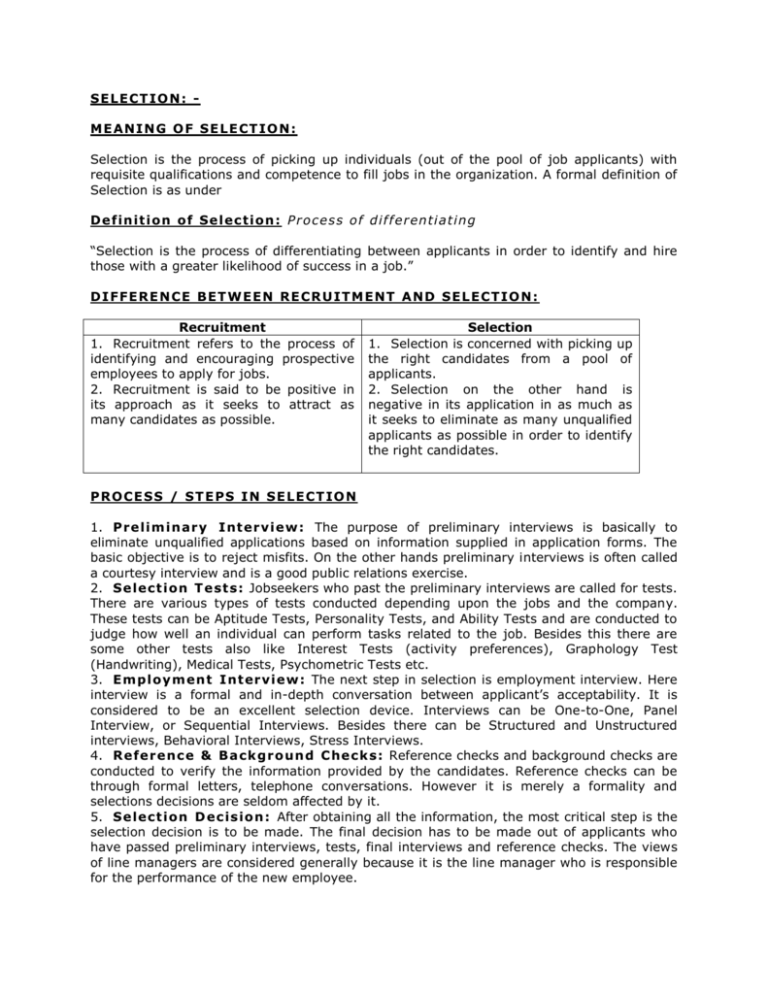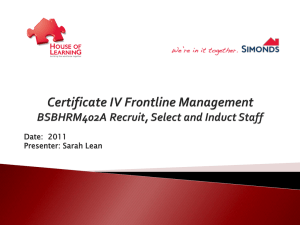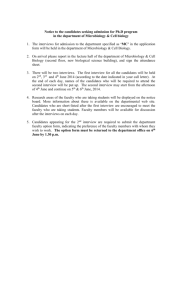SELECTION - SNS Courseware
advertisement

SEL ECT IO N : ME A NI N G O F SE LE CT IO N : Selection is the process of picking up individuals (out of the pool of job applicants) with requisite qualifications and competence to fill jobs in the organization. A formal definition of Selection is as under De f in it i on of Se l ec ti on : P r o c e s s o f dif f e r en ti atin g “Selection is the process of differentiating between applicants in order to identify and hire those with a greater likelihood of success in a job.” DI FF ERE N CE BET W EEN RE CR U ITM E NT A ND SEL ECT IO N : Recruitment 1. Recruitment refers to the process of identifying and encouraging prospective employees to apply for jobs. 2. Recruitment is said to be positive in its approach as it seeks to attract as many candidates as possible. Selection 1. Selection is concerned with picking up the right candidates from a pool of applicants. 2. Selection on the other hand is negative in its application in as much as it seeks to eliminate as many unqualified applicants as possible in order to identify the right candidates. PRO CE SS / ST E PS I N SE LE CT IO N 1. Pr e li m i n ar y I nt er vi e w : The purpose of preliminary interviews is basically to eliminate unqualified applications based on information supplied in application forms. The basic objective is to reject misfits. On the other hands preliminary interviews is often called a courtesy interview and is a good public relations exercise. 2. Se l ect i on T e st s : Jobseekers who past the preliminary interviews are called for tests. There are various types of tests conducted depending upon the jobs and the company. These tests can be Aptitude Tests, Personality Tests, and Ability Tests and are conducted to judge how well an individual can perform tasks related to the job. Besides this there are some other tests also like Interest Tests (activity preferences), Graphology Test (Handwriting), Medical Tests, Psychometric Tests etc. 3. Emp l oy m en t I nt er vi e w : The next step in selection is employment interview. Here interview is a formal and in-depth conversation between applicant’s acceptability. It is considered to be an excellent selection device. Interviews can be One-to-One, Panel Interview, or Sequential Interviews. Besides there can be Structured and Unstructured interviews, Behavioral Interviews, Stress Interviews. 4. Re fe r e nc e & B a ck gr o un d C he ck s: Reference checks and background checks are conducted to verify the information provided by the candidates. Reference checks can be through formal letters, telephone conversations. However it is merely a formality and selections decisions are seldom affected by it. 5. Se l ect i on D ec i s io n : After obtaining all the information, the most critical step is the selection decision is to be made. The final decision has to be made out of applicants who have passed preliminary interviews, tests, final interviews and reference checks. The views of line managers are considered generally because it is the line manager who is responsible for the performance of the new employee. 6. Ph ys i c al Ex am i n a ti on : After the selection decision is made, the candidate is required to undergo a physical fitness test. A job offer is often contingent upon the candidate passing the physical examination. 7. Jo b O f f er : The next step in selection process is job offer to those applicants who have crossed all the previous hurdles. It is made by way of letter of appointment. 8. Co nt r ac t o f Em pl o ym en t : After the job offer is made and candidates accept the offer, certain documents need to be executed by the employer and the candidate. Here is a need to prepare a formal contract of employment, containing written contractual terms of employment etc. ESS E NTI A LS O F A GO O D SE LE CT IO N PR A CT ICE 1. Detailed job descriptions and job specifications prepared in advance and endorsed by personnel and line management 2. Trained the selectors 3. Determine aids to be used for selection process 4. Check competence of recruitment consultants before retention 5. Involve line managers at all stages 6. Attempt to validate the procedure 7. Help the appointed candidate to succeed by training and management development B AR R IE RS T O E FF ECT I VE S ELE CT IO N : 1. Pe rc e pt io n : We all perceive the world differently. Our limited perceptual ability is obviously a stumbling block to the objective and rational selection of people. 2. F ai r n es s : Barriers of fairness includes discrimination against religion, region, race or gender etc. 3. V a l id it y : A test that has been validated can differentiate between the employees who can perform well and those who will not. However it does not predict the job success accurately. 4. Re l i ab i l it y : A reliable test may fail to predict job performance with precision. 5. Pr e ss u r e: Pressure brought on selectors by politicians, bureaucrats, relatives, friends and peers to select particular candidate are also barriers to selection.






